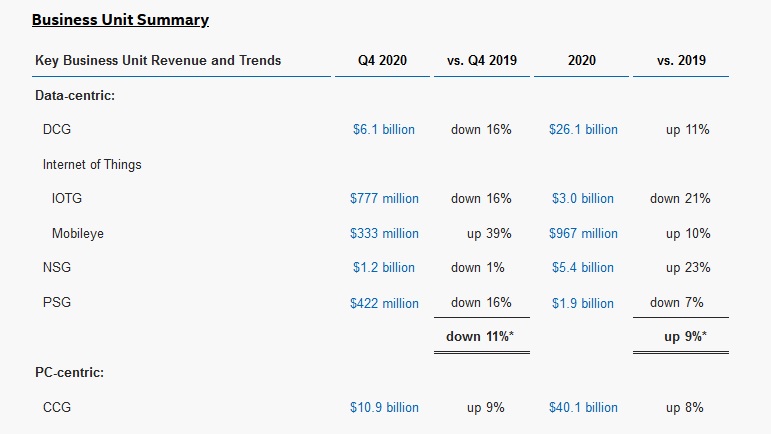He's been called a "bean counter" who doesn't get Intel's engineering challenges, but outgoing CEO Bob Swan is leaving in style, with the former Chief Financial Officer at the world's biggest chip company signing off his last earnings call by delivering a fifth consecutive year of record revenue -- with Q4 performance exceeding guidance by a hefty $2.6 billion.
Healthy though that looks, Intel's lost engineering edge has been blamed by chip watchers on an approach that focuses on chasing quarterly earnings results; making "stock price rather than technology the product". (As Moore's Law slows, tech gets more expensive and heavy investment is needed to sustain a competitive lead. Critics say Intel has underinvested)
Joining the earnings call two weeks before he is formally due to take the reins meanwhile, incoming CEO Pat Gelsinger (a well-respected technologist who joined Intel at 18, going on to become CTO) noted that he had "the opportunity to personally examine progress on Intel’s 7-nanometer technology over the last week" and was "pleased with the progress".
We’re not interested in just closing gaps, we’re interested in resuming that position of the unquestioned leader in process technology - Pat Gelsinger.
Progress on delivering the latest production line of cutting edge Intel chips has been bedevilled by what Intel in summer 2020 described as a "defect mode in our 7-nanometer process that resulted in yield degradation". Gelsinger added on the earnings call: "I am confident that the majority of our 2023 products will be manufactured internally... [but given portfolio breadth] it’s likely that we will expand our use of external foundries."
Intel veterans say that culture has stymied engineering innovation over the past decade, with one noting in a LinkedIn thread that "you cannot buy a mouse without intense scrutiny from operations, much less a scope; engineering decisions got relegated and took over by accountants..."
Pushed by analysts on Taiwanese foundry TSMC's statement that it will begin advanced 3nm production this year and Intel's need to play catch-up, Gelsinger added: "We’re not interested in just closing gaps.
"We’re interested in resuming that position of the unquestioned leader in process technology and that’s our commitment."
Sceptical analysts quizzing Gelsinger on his confidence pointed to numerous broken promises in the past by Intel on technology development, challenging the incoming CEO on how they could trust orogress is happening. A leadership shake-up is coming, he suggested.
"You’ll be seeing we’re making adjustments in the leadership of our product development teams as well where talent is going to come into the company... You’ll be seeing key leaders coming back in."

Intel faces challenges from huge improvement in Arm-based chipsets including those delivered by AWS -- whose Graviton2 just out-performed Intel and AMD chips in a recent multicore performance test.
Pressed on that point, CEO Bob Swan noted: "Process technology is very important [but so is], packaging technologies... a multitude of architectures, CPU to XPU or including graphics and AI capabilities, memory, security and last but not least software... that’s kind of the strategy we’ve been on."
(Intel recently announced the "gold release" of its oneAPI toolkit, which aims to offer a cross-architecture programming model all in one place, without proprietary lock-in, while allowing you to integrate legacy code. The Intel oneAPI lets users create code for both CPUs and "XPUs" or other processing units like FPGAs or GPUs within a single environment.
Overall in 2020 Intel delivered $77.9 billion in revenue, up 8% and $5.30 in EPS, up 9% for the full year. The company is now shipping its first 10nm "Ice Lake" CPU and will be ramping volume through the first quarter.









